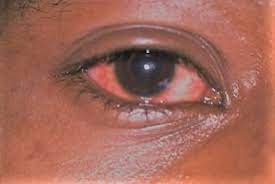More about the eye disease that threatens Rwandans known as Amarundi
A few days ago in Rwanda, there was an eye disease called Amarundi, but it is usually called 'Viral Conjunctivitis'. This disease is spread mainly during winter through an insect called 'Adenovirus'.
The one who caught it is characterized by symptoms like runny nose, headache, coughing, and more.
On February 11, 2024, the Ministry of Health urged all Rwandans to take measures to prevent eye disease when it was discovered that it had arrived in Rwanda. It was after he had visited countries like Kenya and Tanzania for some time.
This disease is transmitted through many ways such as public places, shaking hands with an infected person who has touched their face without washing it, using a device that they have used, and in other ways, according to the data.
Those who have this disease are characterized by high fever, headache, cough, dehydration, severe cold, stuffy nose, and shortness of breath.
It continues to affect quite a few people, where the patient has swollen eyes, feels hypothermia, and has blurred vision.
That's not the only characteristic because the sufferer is also very tired in the morning to the point that it is difficult to open the eyes, it is difficult to look at the sun, and the eyes are very red.
This eye disease caused by the 'Adenovirus' virus affects people of all ages, although the majority are young children because they are often in contact with their peers, and are impatient to avoid close contact.
This disease is transmitted in different ways according to the National Institute of Health, RBC. The only solution to prevent it is that when the sick person is going to cough, he should use a cloth to cover his mouth but not use his hand so as not to spread the air to others.
Another way to prevent this disease is to avoid hugging someone who is sick, to share things that have been touched by someone who is sick, not to go to the 'swimming pool' because it is shared with different people, to avoid sharing cleaning equipment and to wash with clean water and soap every time you leave the bathroom because If you have been dealing with many insects that can cause you to suffer from this disease.
Anyone who has heard of these symptoms should go to the doctor immediately and receive medication, while those who are ill should avoid all activities that bring them in contact with others.
Causes, symptoms & how to prevent red eye disease
The disease which has hit Dar es Salaam, Tanzania has now been reported in Mombasa
Over the past few days, there has been a growing concern about the increasing cases of red eye diseases, which have become common around the coastal city of Mombasa.
The highly contagious disease has been recorded in Dar es Salaam, Tanzania, and has since been reported in Kenya.
Characterized by the telltale redness of the eye, this condition, formally known as conjunctivitis, has caused panic.
In this article, we will explore the causes, symptoms, and treatment of red eye disease.
Causes of the Red Eye disease
Conjunctivitis can be caused by viruses, bacteria, and allergens.
Bacterial infections, notably strains of bacteria such as Staphylococcus or Streptococcus, also contribute to the initiation of conjunctivitis. Additionally, irritants like smoke, dust, or chemicals can trigger the inflammation of the conjunctiva, the clear layer covering the white part of the eye.
Symptoms of red eye disease
Identifying the red eye disease hinges on recognizing its distinctive symptoms. The most apparent sign is, unsurprisingly, the redness of the eye due to blood vessels becoming dilated and inflamed.
Beyond the obvious discoloration, individuals may experience itching, a gritty sensation, excessive tearing, and pain.
The eyes may discharge a watery or mucous-like substance, leading to the formation of crusts, particularly after sleep. Sensitivity to light can also accompany the condition, intensifying the discomfort.
Occasionally, some patients may experience blurred vision, headaches, and a running nose.
Treatment and prevention of Red Eye disease:
Red eye has no specific treatment as it usually disappears one to two weeks after the patient has been infected.
However, preventive measures can be adopted to prevent the spread and escalation of the disease.







No comments:
Post a Comment